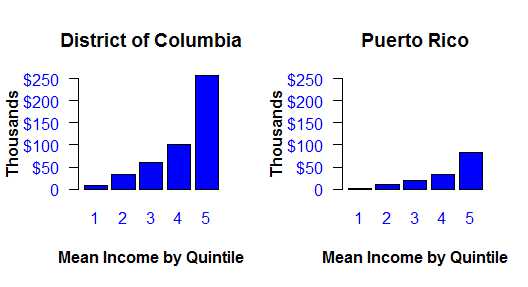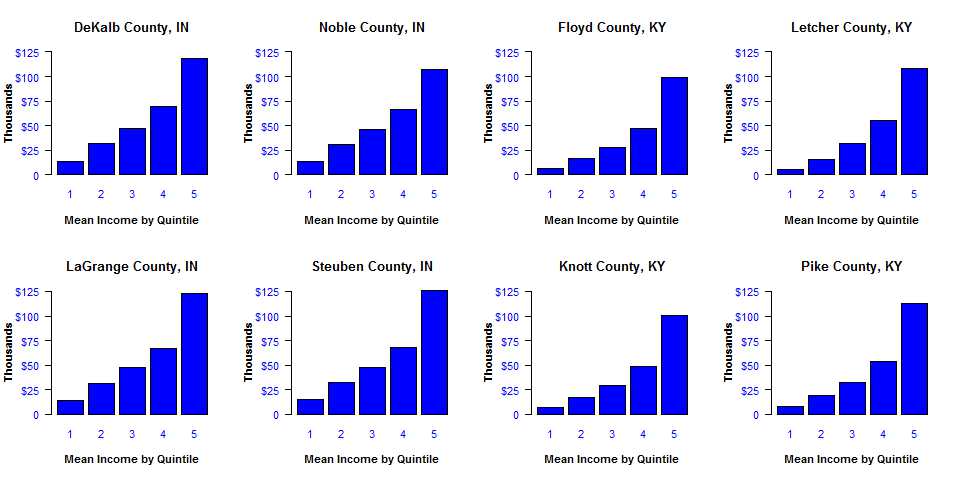Subscribe to Blog via Email
Good Stats Bad Stats
Search Text
May 2025 S M T W T F S 1 2 3 4 5 6 7 8 9 10 11 12 13 14 15 16 17 18 19 20 21 22 23 24 25 26 27 28 29 30 31 -
Recent Posts
goodstatsbadstats.com
Income Inequality Measures Revisited
Last week I posted a piece about the release by the Census Bureau of the report Household Income Inequality Within U.S. Counties: 2006–2010. They used 2006 to 2010 American Community Survey data. Their chosen measure of income inequality was the Gini index. Wikipedia provides a good description of how this measure is computed so I will not go into those details here.
When the DC Fiscal Policy Institute released the report Big Gap: Income Inequality in the District Remains One of the Highest in the Nation they used a different measure of income inequality. They chose the ratio of the mean income of those in the upper quintile of the income distribution to the mean income of those in the bottom quintile of the income distribution.
A post at al.com titled “Jefferson income inequality ranks among highest in state, Census says” dug deeper into the job of examining what the data meant. They examined income inequality in the state of Alabama using the same American Community Survey. They observed that many counties with high measures of income inequality are the same counties with “widespread and long-term poverty.” What was happening in these counties was the the higher level of the Gini index was being driven in large part by the very low income at the bottom end of the income distribution.
That is where the Gini index fails to adequately capture the story of what is happening with income in this country. The calculation of the Gini index is such that if the income of every person in a county were to suddenly double the Gini index would remain essentially unchanged. Disproportionately high income as the upper end of the income distribution as well as disproportionately low incomes at the lower end of the income distribution both can result in higher values for the Gini index. The index itself will tell the analyst nothing about the level of income or about what part of the income distribution is driving its value.
 The graphic to the right illustrated the first point using the same five years of American Community Survey Data. The Gini index for the District of Columbia is 0.535 and the index for Puerto Rico is 0.538. They are both what would be considered very high values for the index. Yet it is readily apparent in the graphic just how much lower are income levels in Puerto Rico. The Gini index for the two jurisdictions are very much the same because the income distribution have approximately the same percentage of households in each income cell. The fact that the income levels are vastly different does not affect the index.
The graphic to the right illustrated the first point using the same five years of American Community Survey Data. The Gini index for the District of Columbia is 0.535 and the index for Puerto Rico is 0.538. They are both what would be considered very high values for the index. Yet it is readily apparent in the graphic just how much lower are income levels in Puerto Rico. The Gini index for the two jurisdictions are very much the same because the income distribution have approximately the same percentage of households in each income cell. The fact that the income levels are vastly different does not affect the index.
But the problems go beyond this one issue. The Census Bureau provided as a part of their report income inequality a nice looking graphic showing the level of the Gini index by county. But comparing the value of the Gini index across counties is very problematic. It is never clear what the underlying reasons for the difference are between the counties. The series of plot below indicate just one aspect of the situation. It illustrates what was happening in Alabama. I picked four counties in the North Eastern corner of Indiana and four counties in Eastern Kentucky. The Gini index for the four counties in Indiana are between 0.36 and 0.38. That puts them in the bottom 20% of the range of Gini indexes across the country. The four counties in KY are at opposite end of the scale all being in the upper 20% of the range of Gini index with numbers between 0.46 and 0.48. So by traditional measures they have the largest levels of income inequality.
At first glance the distributions do not look all that different. But notice how much lower incomes are in the first quintile in the KY counties. This difference does not carry over in same proportion at the high end of the income scale. The ratio of the mean income for the fifth quintile to the first quintile is about 8.5 in the IN counties. That same ratio is over 15 in the KY counties. The four KY counties consistently have lower incomes for each quintile. The gap at the fifth quintile is still there but is proportionality smaller than for the other four quintiles. In the end the reason for the higher levels of the Gini index in the KY counties is due to primarily to lower incomes in the bottom four quintiles combined with a smaller income gap in the top quintile. This is true at least in terms of average income in each quintile. So a fair conclusion would be the the four KY are suffering across all but the high income levels relative to the IN counties. This shows up when we look at median household income. The same ACS 5-year data show a median household income for the United States of about $52,000. The four counties in KY are far below this at around $30,000. Should we then really be concerned about the apparent high level of income inequality in the KY counties?
Posted in Methodolgy Issues
